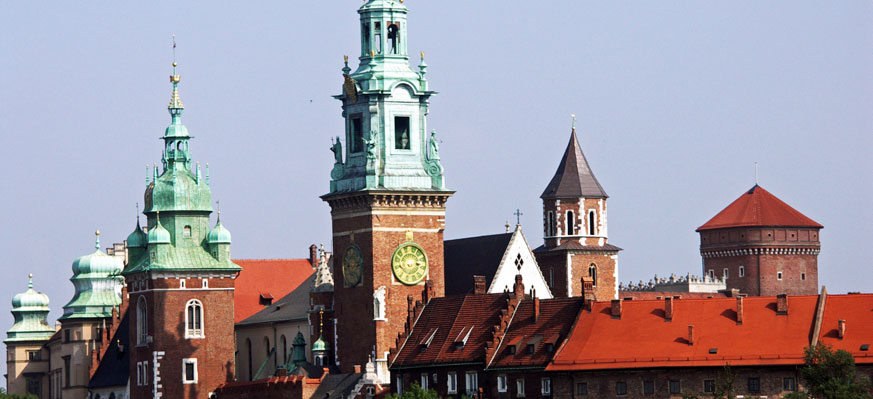The Catholic Pilgrim's Guide to Kraków, Poland

Kraków, the historic heart of Poland, lies along the Vistula River in the Lesser Poland region. With a population of over 800,000, this city, nestled at the foot of the Carpathian Mountains, is a vibrant center of Polish culture and Catholicism. Founded in the 7th century, Kraków served as Poland’s capital until 1596 and remains its spiritual and cultural soul, often called the “Northern Rome” for its abundance of churches and saints. Christianity took root here with the baptism of Mieszko I in 966, shaping Poland’s identity for over a millennium. Home to saints like John Paul II and Faustina Kowalska, Kraków draws millions of pilgrims to its sacred sites, blending Gothic, Renaissance, and Baroque architecture with profound spiritual significance.
1. Wawel Cathedral
Local Name (Polish): Katedra Wawelska
Colloquial Name: Wawel Cathedral (English/Polish)
🏛️ Type: Cathedral, Royal Necropolis, Relic Shrine
📖 Description / Highlights:
Perched atop Wawel Hill, the Royal Archcathedral Basilica of Saints Stanislaus and Wenceslaus is Poland’s spiritual epicenter. Built in the 14th century, this Gothic masterpiece hosted coronations and burials of Polish monarchs. It houses the relics of St. Stanislaus, Poland’s patron saint, in an ornate silver sarcophagus, and the Sigismund Bell, one of Europe’s largest, in its 70-meter tower. The Renaissance Sigismund Chapel, a jewel of Polish architecture, and the crypts of national heroes like Tadeusz Kościuszko make it a must-visit. Pilgrims flock to venerate St. Jadwiga and St. Stanislaus, with over 2 million visitors annually.
🧭 Directions:
2. St. Mary’s Basilica
Local Name (Polish): Bazylika Mariacka
Colloquial Name: Kościół Mariacki (Polish) / St. Mary’s (English)
🏛️ Type: Minor Basilica, Marian Shrine
📖 Description / Highlights:
Dominating Kraków’s Main Market Square, this 14th-century Gothic basilica is renowned for its Veit Stoss altarpiece, the world’s largest Gothic wooden altarpiece, restored in 2021 after Nazi looting. Its uneven towers and star-studded blue ceiling captivate visitors. The hourly “Hejnał” bugle call from the taller tower commemorates a medieval trumpeter. A UNESCO World Heritage Site, it draws pilgrims for its Marian devotion and hosts over 1.5 million visitors yearly.
🧭 Directions:
3. Divine Mercy Sanctuary
Local Name (Polish): Sanktuarium Bożego Miłosierdzia
Colloquial Name: Łagiewniki Sanctuary (Polish/English)
🏛️ Type: Pilgrimage Site, Saint Shrine
📖 Description / Highlights:
Located in Łagiewniki, this modern sanctuary is dedicated to St. Faustina Kowalska, who received visions of the Divine Mercy. The basilica, consecrated in 2002 by Pope John Paul II, houses her relics and the iconic Divine Mercy image. Pilgrims pray the Divine Mercy Chaplet at 3:00 PM daily, with over 2 million visitors annually. The adjacent John Paul II Center holds his blood relics, making it a dual pilgrimage site.
🧭 Directions:
4. Basilica of St. Francis of Assisi
Local Name (Polish): Bazylika św. Franciszka z Asyżu
Colloquial Name: St. Francis Basilica (English/Polish)
🏛️ Type: Minor Basilica, Artistic Shrine
📖 Description / Highlights:
This 13th-century Gothic church in Kraków’s Old Town is famed for its vibrant stained glass and murals by Stanisław Wyspiański, a Young Poland artist. A copy of the Turin Shroud and a plaque marking Karol Wojtyła’s pew add spiritual depth. Rebuilt after multiple fires, it blends Gothic and neo-Gothic styles, attracting pilgrims and art lovers. Open daily, it offers a serene space for prayer.
🧭 Directions:
5. Skałka Basilica
Local Name (Polish): Bazylika św. Michała Archanioła i św. Stanisława
Colloquial Name: Church on the Rock (English) / Skałka (Polish)
🏛️ Type: Minor Basilica, Saint Shrine
📖 Description / Highlights:
Known as the “Church on the Rock,” this 18th-century Baroque basilica on the Vistula River is where St. Stanislaus was martyred in 1079. Its crypt houses prominent Poles, including artists and writers. The Pauline monastery and serene grounds enhance its spiritual ambiance. Regular Masses and its historical significance draw thousands of pilgrims yearly.
🧭 Directions:
6. Church of Sts. Peter and Paul
Local Name (Polish): Kościół św. Piotra i Pawła
Colloquial Name: Sts. Peter and Paul (English/Polish)
🏛️ Type: Parish Church, Baroque Monument
📖 Description / Highlights:
Built in the early 17th century, this Jesuit church on Grodzka Street is Poland’s first Baroque structure. Its façade, adorned with statues of the Twelve Apostles, and lavish interior by Italian architects make it a standout. Commissioned by King Sigismund III Vasa, it reflects Counter-Reformation zeal. Its proximity to Wawel Hill makes it a key stop on the Royal Route.
🧭 Directions:
7. Corpus Christi Basilica
Local Name (Polish): Bazylika Bożego Ciała
Colloquial Name: Corpus Christi (English/Polish)
🏛️ Type: Minor Basilica, Gothic Shrine
📖 Description / Highlights:
This 15th-century Gothic basilica in Kazimierz, Kraków’s historic Jewish quarter, boasts intricate woodwork and frescoes. It houses the tomb of Bartolomeo Berrecci, architect of the Sigismund Chapel. Its serene atmosphere and historical significance make it a hidden gem for pilgrims seeking quiet reflection. Open daily, except during Masses.
🧭 Directions:
🛏️ Where to Stay
Near Wawel Cathedral & St. Mary’s Basilica (Old Town, 1st District)
Near Divine Mercy Sanctuary (Łagiewniki)
Near Skałka & Corpus Christi (Kazimierz)
Budget-Friendly
Pilgrim-Specific